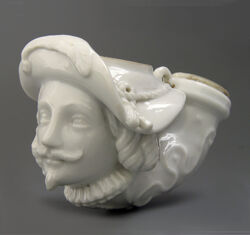Musketeer in Blanc-de-Chine
September 2021

The designer of this unpainted porcelain pipe bowl has given the musketeer with mustache and goatee a typical seventeenth-century appearance. That look is accentuated by a wide-brimmed hat with a feather, pipe curls to the shoulders and a modest ruffle collar. Characteristic of the time of its creation is the cuff with mounting rim intended to attach a silver stem holder. Furthermore, we see that the cord of the hat flips up slightly to act very subtly as an eye for a locking cord. Originally, a musketeer meant a city guard who kept the enemy at a distance with his musket rifle. From 1844 the word musketeer takes on a new meaning through the novel by the Frenchman Alexandre Dumas: Les trois mousquetaires. These were members of a guard of honor for the French king from the 1620s to 1640s, with D'Artagnan in a leading role, alongside the musketeers Aramis, Athos and Parthos. This majestic porcelain pipe bowl must have been conceived at the beginning of that craze, so shortly after 1844. The allover design is typical Second Empire, although in detail it still reflects characteristics of the eighteenth century porcelain tradition, especially in the ruffled jabot. The size and the stem decoration, on the other hand, are characteristic of the time of creation, demonstrated in the somewhat unpronounced ornamentation on the stem. The Blanc-de-Chine version is attractive. With the garish color painting of the 1840s, much of the subtlety of the design would undoubtedly have been lost.
Amsterdam Pipe Museum APM 24.286
Permalink